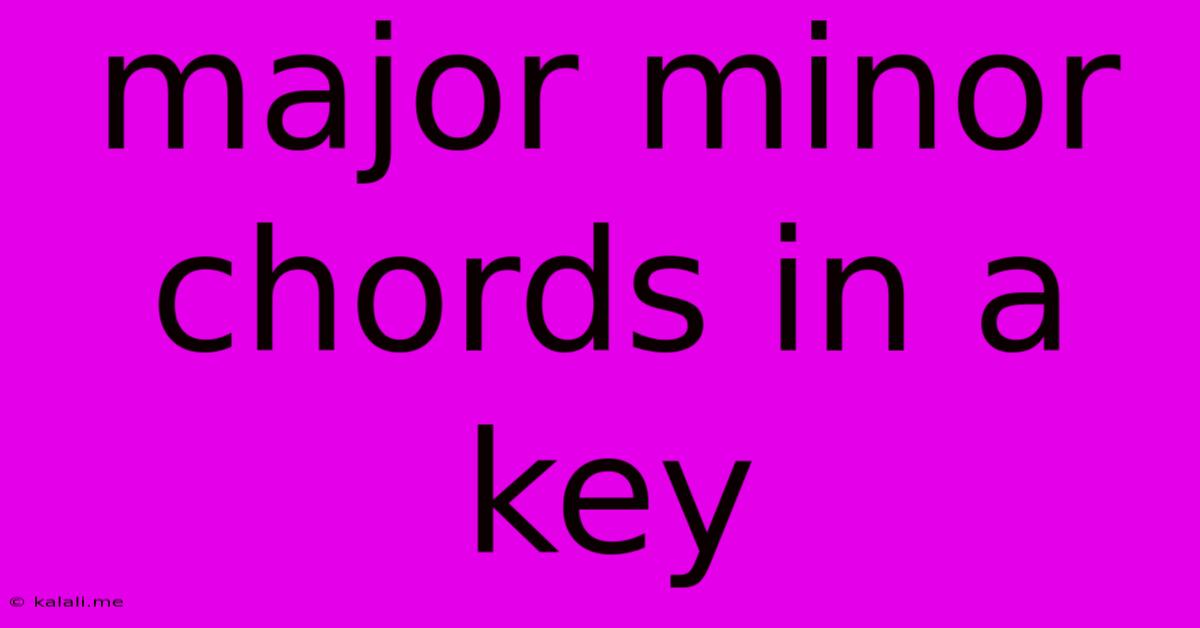Major Minor Chords In A Key
Kalali
Jun 01, 2025 · 3 min read

Table of Contents
Major and Minor Chords in a Key: Understanding the Building Blocks of Harmony
Understanding major and minor chords within a key is fundamental to music theory and composition. This article will delve into the construction and function of these chords, providing a clear guide for musicians of all levels. Knowing how to identify and use them effectively will significantly enhance your musical understanding and compositional skills.
What are Major and Minor Chords?
A chord is a combination of three or more notes played simultaneously. Major and minor chords are the most basic types, distinguished by the intervals between their constituent notes. A major chord is built using a major third and a perfect fifth above the root note. A minor chord uses a minor third and a perfect fifth above the root.
Let's break down the intervals:
- Major Third: Four semitones (e.g., C to E)
- Minor Third: Three semitones (e.g., C to Eb)
- Perfect Fifth: Seven semitones (e.g., C to G)
Building Chords in a Key:
Each key has a unique set of major and minor chords associated with it. These chords are derived from the key's diatonic scale – the seven notes that make up the key's characteristic sound. For example, let's consider the key of C major:
C Major Scale: C D E F G A B C
From this scale, we can build the following chords:
Major Chords in C Major:
- C Major (I): C - E - G (Tonic Chord - the home base)
- F Major (IV): F - A - C (Subdominant Chord - creates a sense of anticipation)
- G Major (V): G - B - D (Dominant Chord - creates strong pull towards the tonic)
Minor Chords in C Major:
- A minor (vi): A - C - E (Submediant Chord - adds a touch of melancholy)
- D minor (ii): D - F - A (Supertonic Chord - often used to create tension and resolution)
- E minor (iii): E - G - B (Mediant Chord - less frequently used than the others)
Understanding Chord Function:
The Roman numerals (I, ii, iii, IV, V, vi) represent the chord's function within the key. This is crucial for understanding harmonic progression. The tonic (I) provides stability, the dominant (V) creates tension leading to resolution, and the subdominant (IV) adds a sense of anticipation. The minor chords add color and complexity to the harmonic landscape.
Applying this to other keys:
The process remains consistent for other keys. Simply use the notes of the relevant major scale to build the major and minor chords. For example, in the key of A major, the major chords would be A major (I), D major (IV), and E major (V), while the minor chords would be F#m (vi), C#m (ii), and Bm (iii).
Practical Application and Further Exploration:
Understanding major and minor chords in a key is essential for:
- Composition: Creating melodies and harmonic progressions.
- Improvisation: Building solos and chord voicings.
- Analysis: Deconstructing existing musical pieces.
Experiment with different chord progressions within various keys. Listen to music and try to identify the major and minor chords being used. The more you practice, the more intuitive this process will become. This foundational knowledge opens the door to a deeper understanding of music theory and unlocks a world of creative possibilities.
Latest Posts
Latest Posts
-
Investing In South Park Stick Of Truth
Jun 03, 2025
-
Find An Explicit Solution Of The Given Initial Value Problem
Jun 03, 2025
-
Borderlands Pre Sequel Outlands Canyon Electric Fence
Jun 03, 2025
-
How To Add Gifs As Pfp On Instagram
Jun 03, 2025
-
Toeing The Line Or Towing The Line
Jun 03, 2025
Related Post
Thank you for visiting our website which covers about Major Minor Chords In A Key . We hope the information provided has been useful to you. Feel free to contact us if you have any questions or need further assistance. See you next time and don't miss to bookmark.